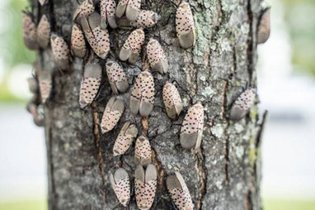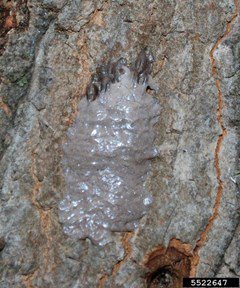If you haven’t heard of the spotted lanternfly, or you don’t know too much about it, let’s get you up to speed on this invasive insect.
There’s a lot of ground to cover when it comes to this pest. But, it’s very important for fellow tree owners to know all about the appearance, damage, and management of the spotted lanternfly in order to keep the plants in your yard—and the ones in your community—protected.
So without further delay, here are some of the big need-to-knows about the spotted lanternfly.
Identification: what does spotted lanternfly look like?
Identification is easy, thanks to the insect’s distinct looks throughout its life cycle. You’ll see a different appearance depending on the season:
- In early spring, look for all-black insects with white spots
- Later in spring and closer to summer, look for bright red insects with white spots and black stripes
 In summer and into the fall season, look for fully-grown flying insects with a set of brown wings with black dots, a set of bright red wings with black dots, and a yellow and black-striped body
In summer and into the fall season, look for fully-grown flying insects with a set of brown wings with black dots, a set of bright red wings with black dots, and a yellow and black-striped body
What do spotted lanternfly eggs look like?
The pest covers its eggs with a protective coating. So while you won’t see the eggs themselves, you might see the covering, which looks like a clump of whitish-brown mud. Keep in mind that spotted lanternfly egg masses are found on the trunk of your tree, but they also might be on other smooth, hard surfaces like patio tiles or outdoor furniture.
What states have spotted lanternflies?
Back in 2014, Pennsylvania was the only state with a SLF sighting. It’s still there today, plus New York, New Jersey, Delaware, Massachusetts, and Virginia have also had SLF infestations.
How did the spotted lanternfly get to the United States?
It’s not crystal clear how this insect made its way from its homeland of China to the United States. Most likely, it was carried over on products that were shipped internationally.
What trees are affected by spotted lanternfly?
If this pest had to pick favorites, the tree-of-heaven would top the list.
But that doesn’t mean the pest gives other trees the cold shoulder. Here are few other trees impacted by SLF:
- Apple
- Oak
- Maple
- Willow
- Several other deciduous trees have been affected.
What does spotted lanternfly tree damage look like?
Common signs of SLF feeding include leaf wilting, leaf curling, and sap spilling from tree wounds and branch dieback.
In addition, these insects produce a clear, sticky liquid called honeydew. Insects like ants and wasps really like honeydew, so you might see these pests hanging around your tree.
Also, honeydew encourages the growth of the sooty mold fungus, which essentially looks like dusty black patches on tree leaves or branches.
Keep in mind that some of these symptoms (particularly honeydew and sooty mold) are also trademarks of scale insects or aphids. You’ll know for sure that SLF is the culprit if you see some of these symptoms and the insect itself.
Why are spotted lanternflies dangerous to trees?
SLF damage is serious for two main reasons;

- As the insects feed, they slowly take sap away from the tree, which strips away nutrients; and
- Infested trees are weakened and, in some cases, could die from SLF feeding.
How do you get rid of spotted lanternflies?
OK, now that you’ve read all about the “what” and “why,” let’s talk about how to handle a SLF infestation.
One effective strategy is removing any tree-of-heaven plants from your yard. As mentioned, this tree is the #1 host, so removal could help control the pest’s spread.
If you don’t have a tree-of-heaven, but SLF is still in your community or in your own backyard, read about what precautions you can take here.
What do you do if you see a spotted lanternfly?
A key question you might have is: how do I report an infestation?
First, a huge thanks for your due diligence! It's a big help when homeowners take action to help manage this pest issue.
The best thing you can do is let your state’s Department of Agriculture know that you saw the pest.
You can visit your department’s website or give them a call to find out what information they’ll need to document the sighting.
Your local arborist is also here to help.






